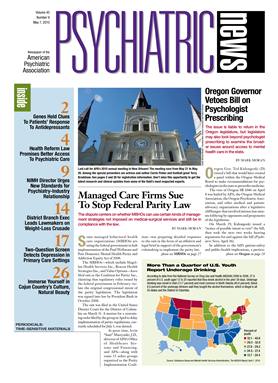An increasing variety of police programs for responding to emergencies involving people with a serious mental illness has emerged over the last 20 years. A report prepared for the Department of Justice has now pinpointed characteristics of programs that have been successful in diffusing tense situations between police and individuals with mental illness.
Although all special response units (SPRs), as these police programs are generally called, have common features, well-functioning programs included variations in program designs that were tailored to the jurisdiction's size, demographics, mental health and law enforcement agency resources, and relevant state laws, according to the report that the Council of State Governments Justice Center prepared for the Department of Justice.
In addition, the cities and counties that had successful programs used approaches to forming SPRs that made collaboration between law enforcement, community members, and mental health professionals a key element of the initiatives.
Such successful programs also were designed to address specific problems that departments faced regarding their interaction with people who have a psychiatric illness, such as frequent calls for service from one individual or poor outcomes in past situations in which police were confronted with a person who was mentally ill. Others focused their resources on neighborhoods or areas to which they were frequently called or on a specific population such as homeless people with mental illness.
This first national effort to analyze how jurisdictions develop and modify effective approaches to police interaction with those who have mental illness came as a growing number of cities and counties have sought to improve the outcomes of potentially volatile situations in which police are confronted with someone who appears to be mentally ill.
The earliest of the SPR approaches is known as the Crisis Intervention Team (CIT), which was launched in Memphis in 1987 after local officers killed a mentally ill man during a confrontation. The Memphis Police Department worked with the local branch of the National Alliance on Mental Illness and local mental health professionals to teach the police more effective and nonlethal ways to manage interactions with people displaying signs of mental illness. The CIT approach was successful enough that an estimated 400 CIT programs have been launched by local and state law enforcement units nationwide.
“CITs have been extremely successful in Tennessee and elsewhere,” said Laurel Stine, a lobbyist for the Bazelon Center for Mental Health Law.
In general, the CIT approach trains police officers to use response techniques that can deescalate situations involving people with mental illness. There are, however, different models of SPR programs that also are successful. One common program pairs police with mental health professionals—known as the co-responder model—who report to situations involving people suspected of being mentally ill.
The new guidance for jurisdictions looking to add special police programs to better serve people with mental illness came as the leading federal program to encourage such approaches faced difficulty. The Fiscal 2011 budget proposed by President Obama would direct the Problem Solving Court Initiative to absorb the Mentally Ill Offender Treatment and Crime Reduction program, which provides grants to develop both police programs and local courts for crimes involving people with serious mental illness. Mental health advocates worry that the change could result in phasing out funding for the police program in favor of the courts program.
“We definitely have concerns about what would happen to these police programs under the president's budget,” said Stine.
Mental health advocates hope not only to stop the proposed consolidation but to boost the allotted annual funding for the police program from $12 million to $50 million. The increase is needed because the number of state and local governments seeking federal help to launch such programs continues to far outstrip federal resources. For instance, due primarily to a lack of funds in both Fiscal 2006 and Fiscal 2008, only 11 percent of the grant applications for assistance in planning such police programs were approved.
“Local jurisdictions are definitely interested in [these training programs],” Stine said.
